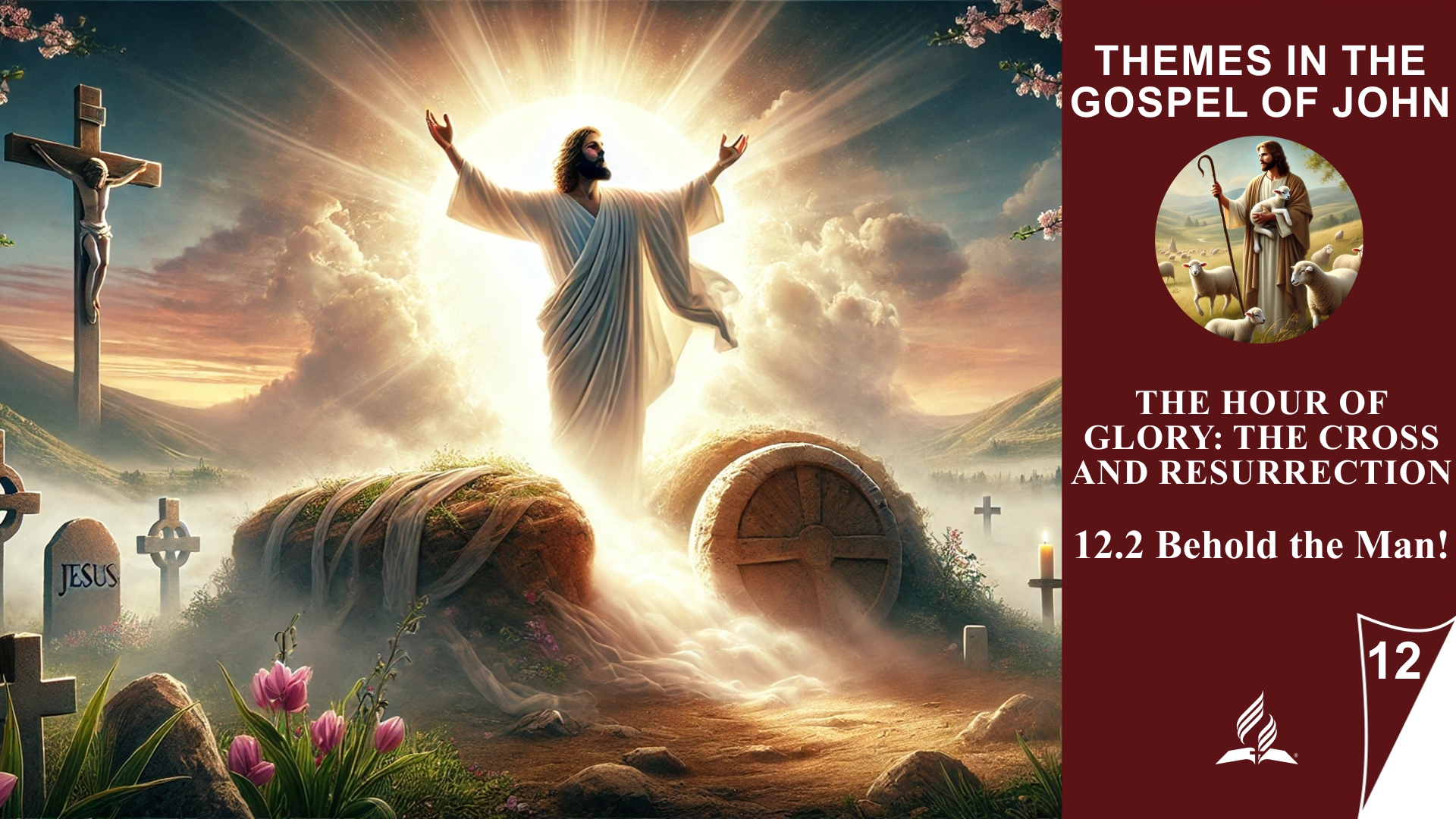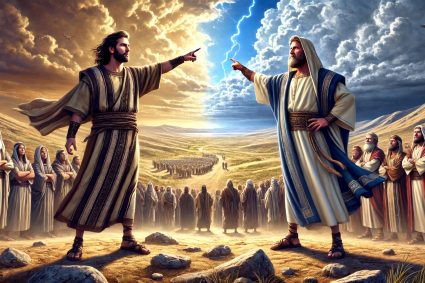


12.2 Behold the Man!
The Irony of Judgment: The True King and the Lamb of God
Read John 18:38–19:5. How does Pilate try to convince the people to request the release of Jesus?
In John 18:38–19:5, we experience one of the most tragic and at the same time profound scenes of the Gospel. The irony and symbolism that permeate this passage emphasize the gravity of the events and reveal the spiritual reality behind the external actions.
-
Pilate’s Uncertainty and Manipulation by the Leaders
Pilate is in a difficult position: he recognizes Jesus’ innocence but is constrained by political and social dynamics. His attempt to persuade the crowd to release Jesus shows both his uncertainty and lack of determination. By invoking the custom of releasing a prisoner, he opens the door wide to manipulation by the religious leaders. They use the crowd to enforce their hatred of Jesus and continually pressure Pilate further. This is a striking image of how power, fear, and social pressure can suppress truth and justice.
-
The Irony of the Scene: See, the Man!
The words “See, the man!” (John 19:5) are full of irony and profound meaning:
-
For Pilate, they are probably an attempt to calm the crowd by presenting Jesus in his humiliated and mocked form. Pilate plays on the people’s pity to achieve Jesus’ release.
-
From a theological perspective, however, the words resonate differently. They evoke the humanity and suffering of Jesus, who in this humiliating depiction is simultaneously the true King and Savior. Jesus wears a crown of thorns, a symbol of the curse of sin (Genesis 3:18), and a purple garment, representing both royal dignity and mockery. This portrayal prophetically points to his sacrifice.
-
The Lamb of God in the Garb of a King
The scene inevitably reminds the reader of John 1:29: “Behold, the Lamb of God, who takes away the sin of the world!” While Pilate presents Jesus mockingly as the “Man,” the believing reader sees more: Jesus is the Lamb of God who willingly takes the path of suffering and humiliation to redeem the world. In the parody of a royal ritual, we recognize the truth: Jesus is the true King whose reign is not of this world (John 18:36).
-
The Tragedy of Hatred and Rejection
The rejection of Jesus by the religious leaders and the people shows the depth of the human heart, marked by pride, fear, and hatred. The leaders, who were supposed to await the coming Messiah, instead choose a criminal (Barabbas) and declare that they have no other king but Caesar. In doing so, they betray not only their national convictions but also their spiritual identity. Their hatred for Jesus is so great that they are willing to sacrifice everything to get rid of him.
-
Meaning for Our Faith and Daily Life
This scene invites us to examine our own hearts:
-
How do we handle the truth? Pilate recognizes Jesus’ innocence but ultimately gives in to pressure. Are we willing to stand up for the truth, even when it becomes uncomfortable?
-
How do we approach Jesus? Do we see him as the true King, or do we let ourselves be guided by prejudices and societal influences, as the crowd did?
-
Where do we set our loyalty? The leaders declared that they have no king but Caesar. To whom or what do we give priority in our lives – Christ or worldly powers?
Conclusion
“See, the man!” is not just Roman mockery but a call to recognize Jesus in his humanity and divinity. He is the true King who humbled himself to bear the sin of the world. The scene challenges us to recognize the truth about Jesus and to follow him with devotion, even if it costs us something. It is a call to consider the love and sacrifice of Christ and to align our faith and daily lives accordingly.
How Dreadful: A Pagan ruler wants to release Jesus, while the spiritual leaders of the nation, who should have recognized him, instead want to crucify him! What lessons can we draw from this?
This dreadful scene, in which a pagan ruler shows more hesitation in condemning Jesus than the spiritual leaders who should have recognized him, offers us valuable lessons for our own lives and faith:
-
Beware of Religious Pride
The religious leaders were convinced that they were in the right because they were the guardians of the law and tradition. But their pride and self-righteousness led them to not recognize the truth, even though it stood right before them.
-
Lesson: We should beware of placing our knowledge or religious achievements above the humility and openness necessary to recognize God’s truth. Faith is not just a matter of knowledge but of the heart.
-
Religion Without Love Leads to Cruelty
The leaders were willing to crucify Jesus because he did not fit their image of a Messiah. Their adherence to the law was driven by hatred, envy, and fear of losing power.
-
Lesson: Religion without love and mercy can be destructive. A faith not permeated by God’s love can hurt people and lead them astray. Our faith should lead us to promote and protect life, not destroy it.
-
The Danger of Groupthink
The crowd blindly followed the religious leaders and called for Jesus’ crucifixion, even though he was innocent. They were manipulated and acted out of fear, pressure, or peer pressure.
-
Lesson: We should critically question whom or what we follow, especially when the majority agrees in one direction. Our faith should be based on the truth in Christ, not on others’ opinions or societal pressure.
-
Secular Faith Can Seem Morally Superior
Pilate, though pagan and motivated by power interests, shows more willingness to respect the truth than the religious leaders. This is a warning that religious people are not automatically morally superior.
-
Lesson: We should beware of seeing our religious life as a guarantee of moral righteousness. True justice is shown in our behavior, in love, compassion, and the willingness to stand up for the truth.
-
The Danger of Power and Control
The religious leaders were so intent on protecting their authority that they were willing to sacrifice their own values and beliefs. They even declared, “We have no king but Caesar” (John 19:15) – a shocking abandonment of their belief in God as King.
-
Lesson: Power and control can blind us to the truth. We should always ask ourselves whether our actions honor God or if we are trying to advance our own interests.
-
Openness to God’s Truth
The religious leaders had studied the scriptures for years and awaited the Messiah, but when he came, they did not recognize him. Their hearts were closed because Jesus did not meet their expectations.
-
Lesson: We should remain open to God’s truth, even if it does not align with our expectations. God often acts differently than we expect – and therein lies his wisdom and grace.
-
The Power of Personal Faith
Pilate was driven by external constraints and let the truth go, even though he recognized it. The religious leaders, on the other hand, should have acted out of their faith but acted out of self-interest.
-
Lesson: Our faith should be so deep and authentic that we are willing to stand up for the truth even in difficult moments. It takes courage to put God’s will above personal or societal advantages.
Summary
This story shows how easily religious pride, lust for power, and group pressure can lead to missing the truth. For us, this means that we should live in humility and love, continually examine our faith, and let the truth in Jesus Christ guide us. Only then can we avoid making the same mistakes as the leaders of that time – and instead be witnesses to the truth.
The scene in which Pilate presents Jesus and lets the crowd decide his release contains profound lessons that are relevant for our daily lives and faith. It shows how power, group pressure, and religious pride can obscure the truth – challenges that are also present in our everyday lives.
Practical Lessons for Daily Life
-
Courage to Speak the Truth in Difficult Moments
Pilate knew that Jesus was innocent, but he did not act according to his conviction. His fear of the consequences led him to suppress the truth.
-
Daily Relevance: How often do we face the decision to stand up for the truth but risk rejection or consequences? In such moments, we can remember Jesus as the true King who gives us the strength to do what is right.
-
Dealing with Prejudices
The religious leaders rejected Jesus because he did not fit their expectations. Their entrenched opinions left no room for God’s work.
-
Daily Relevance: We too tend to judge people or situations based on our expectations. This story invites us to remain open to God’s surprising actions and not be guided by prejudices.
-
Examining Loyalty
The leaders declared, “no king but Caesar,” thereby betraying their true loyalty. They placed their political interests above their faith.
-
Daily Relevance: To whom or what are we loyal? Are we truly following Jesus, or are we letting worldly values like success, power, or recognition guide us? We should continually ask ourselves this question, especially in conflict situations.
-
Responsibility in Communities
The crowd was manipulated by the leaders and called for Jesus’ crucifixion, even though they might have had doubts themselves.
-
Daily Relevance: Group pressure and societal pressure can influence our judgment. This story challenges us to think independently and not blindly follow the majority pressure. We should align our actions with Jesus’ example.
-
Faith with Love Instead of Dogmatism
The leaders were willing to kill Jesus to protect their power and traditions. Their religion had become a cold institution lacking love and compassion.
-
Daily Relevance: Our faith should not be based only on rules but be characterized by love and mercy. The love of Christ should guide our actions and make us instruments of peace.
-
The Power of Personal Faith
Pilate was driven by his fear, the leaders by their hatred. Both let the truth go, even though it was evident.
-
Daily Relevance: Our personal faith should be deeply rooted so that in difficult moments we can trust in God’s truth instead of being driven by fear or hatred.
-
The True Meaning of “See, the Man!”
Pilate’s words “See, the man!” invite us to see Jesus not only as the suffering King but as someone who shares our humanity and bears our burdens.
-
Daily Relevance: This scene reminds us that Jesus knows our struggles and suffering. In moments of weakness, we can entrust ourselves to him and trust that he is our true King and Savior.
Final Summary
The irony of this story is often reflected in our daily lives: we recognize the truth but do not act accordingly; we follow prejudices or the pressure of the majority. This scene encourages us to examine our actions and our faith, to courageously stand up for the truth, and to align ourselves with Jesus Christ in love and mercy. Thus, we can be witnesses to his truth and grace in our daily lives.
In the humility and suffering of Jesus, we recognize the true King who gives himself for us and shows us what real love means.
(Visited 26 times, 1 visits today)























